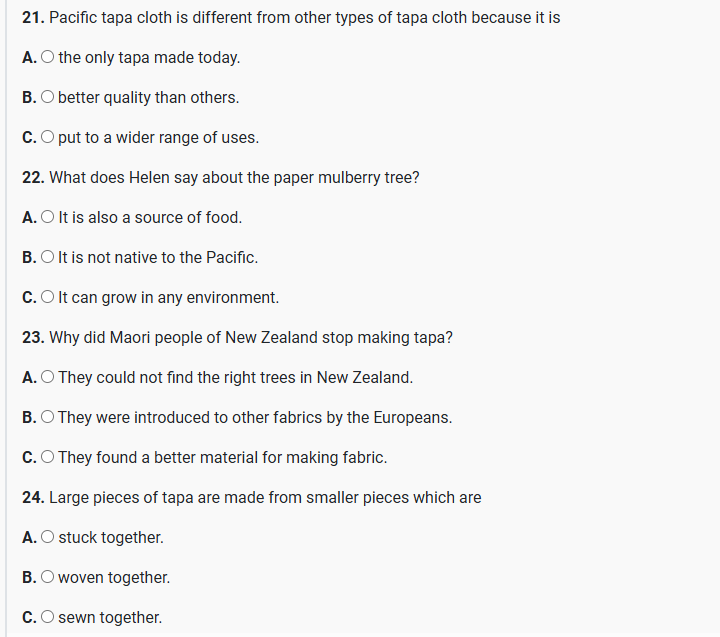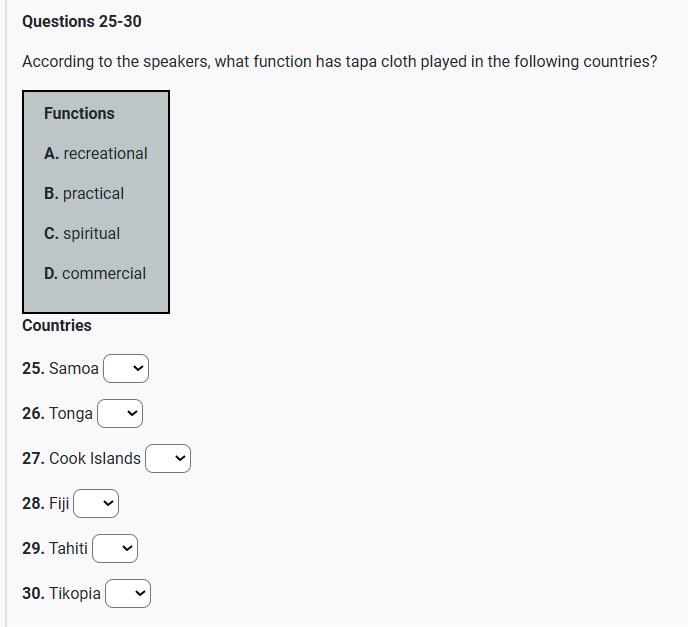
| IELTS listening – Pacific tapa cloth listening practice test has 10 questions belongs to the Culture & Art subject.. |

HELEN: Well, I was going to introduce my assignment by saying that the Tapper cloth is a fabric made from bark, just the outer layer of the trees. It’s particularly Q21 common in the Pacific Islands but not exclusive to them. In fact, many other peoples around the world have made high-quality cloth from back, but what sets Pacific tapa apart is the incredible variety of roles it’s played in this region.
TUTOR: Yes nice introduction, though I think you could be more specific regarding dates. Okay, so what about the raw materials used?
HELEN: Well tough is made from raw species of tree in the Pacific the paper mulberry tree is most common, but it doesn’t thrive in all conditions in fact it wasn’t originally found in the islands but was carried in their canoes by the first migrants. Tapa is also made from the breadfruit tree, which is convenient because its fruit is a staple food the paper mulberry tree is only grown for Tapper making though.
TUTOR: Yes that’s good now what about the Maori people here in New Zealand?
HELEN: The Maori don’t make tapa now.
TUTOR: That’s right and you need to account for it we know that when Mari migrated here from the other Pacific Islands they were prepared to make Tupper because they brought the paper mulberry tree with them. The thing was after they’d been in New Zealand a bit Q23 they found the flax plant which is superior to tapa because it makes a stronger fabric. By the time Europeans arrived in the 18th century, Maori were making all their fabric from flax and had been for some time.
HELEN: Okay so with the production process itself first did the inner bark is beaten with wooden hammers to soften the fibers in the different pieces are glued together using an adhesive paste made from the arrowrooter tuber this is the only way to fabricate large pieces of cloth because bark strains are too fine to be woven together and Q24 stitching isn’t strong enough.
TUTOR: So now you need details about different countries where would you start Samoa is the obvious place it’s famous for its very fine cloth called siapol which is hand-painted with representations of the ancestors. Still today at the most profound events in life such as births funerals weddings and the investiture of chiefs Samoans where siapol robes to add significance and meaning to the ceremony.

HELEN: Okay then I could talk about Tonga, it seems to me that the great innovation in Tonga has been developing a Q26 simple coarse cloth, which is quick and easy to make this is suitable for all sorts of everyday functions around the house like bed covers, mosquito Nets, and curtains.
TUTOR: Good point now what about Cook Islands Tupper?
HELEN: Well the soil there is poor quality so the breadfruit tree is often used. One type of thick cloth called tikuru was wrapped around the poles and used to Mark the entrances to Q27 places of worship so it was highly regarded in local culture.
TUTOR: You might mention Fiji as well which is interesting because tapple was actually Q28 used as a currency there. Fijians used to sail between the islands and exchange tapa for other Commodities like canoes or pigs.
HELEN: I know that in Tahiti the top of cloth is different because the patterns are in color which is considered more valuable than the usual Brown patterns.
TUTOR: You’re right about the Tahitians Q29 using colored pigments, but they aren’t more valuable the colors are only a decoration people enjoy wearing bright robes especially for dancing in competitive games and do it just for fun.
HELEN: Oh I’ll make a note of it. Well, the last place I was going to mention was Tikopia. Even today it’s commonplace to see Q30 people wearing clothes made of tuppercloth and many of the other Islands the tapa only comes out on special occasions, but here you see people working in the gardens wearing Tupper.
TUTOR: Sounds promising Helen I look forward to reading your assignment.
Prepare for IELTS IELTS Test International Experienced Teacher Best Training By CELTA Trainer. Best Results Easily Get Required Score IELTS Exam Dates Available, Small Batch Size with Flexible Time, Professional.
![]()
8439000086
8439000087
7055710003
7055710004
IELTS Simulation 323 GMS Road, Near Ballupur Chowk, Dehradun, India
![]()
email: info at ieltsband7.com
Boost Your Score: Practice IELTS Online with IELTS Simulator Prepare for IELTS Effectively Using IELTS Simulator Ace the IELTS: Try Realistic Practice on IELTS Simulator IELTS Simulator: Online Practice to Improve Your IELTS Score Rocky Bay field trip listening practice test has 10 questions belongs to the Leisure & Entertainment subject. Prepare for IELTS IELTS Test International Experienced Teacher Best Training By CELTA Trainer. Best Results Easily Get Required Score IELTS Exam Dates Available, Small Batch Size with Flexible Time, Professional. Easily Get Required Score I am interested in IELTS Pass with Confidence, Dehradun Small Batch Size with Flexible Time, professional faculty. Learn From Experienced Teacher Best IELTS Coaching Dehradun Best IELTS in Dehradun Uttarakhand GMS Road BEST coaching in Dehradun Apply for Class Courses Today Good Results. Small Batch Size, Flexible Time and Professional IELTS Teacher Best IELTS coaching classes IDP certified British Council trained and CELTA certified experienced trainer. Easily Get Required Score Tel:8439000086 Tel:8439000087 Tel:7055710003 Tel:7055710004 Tel:7055710009